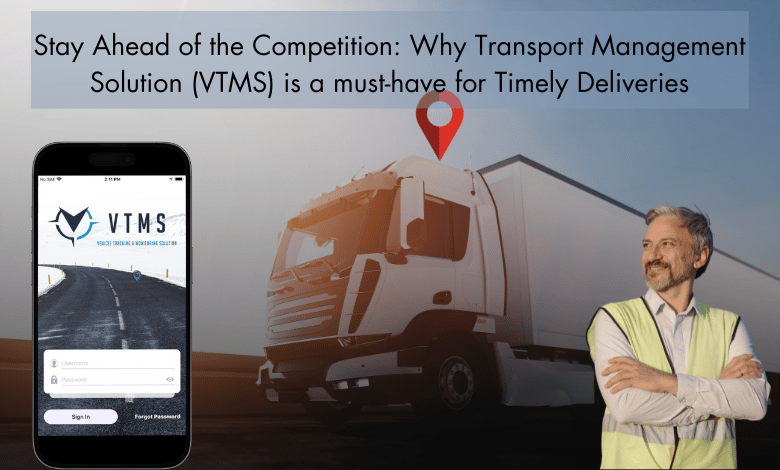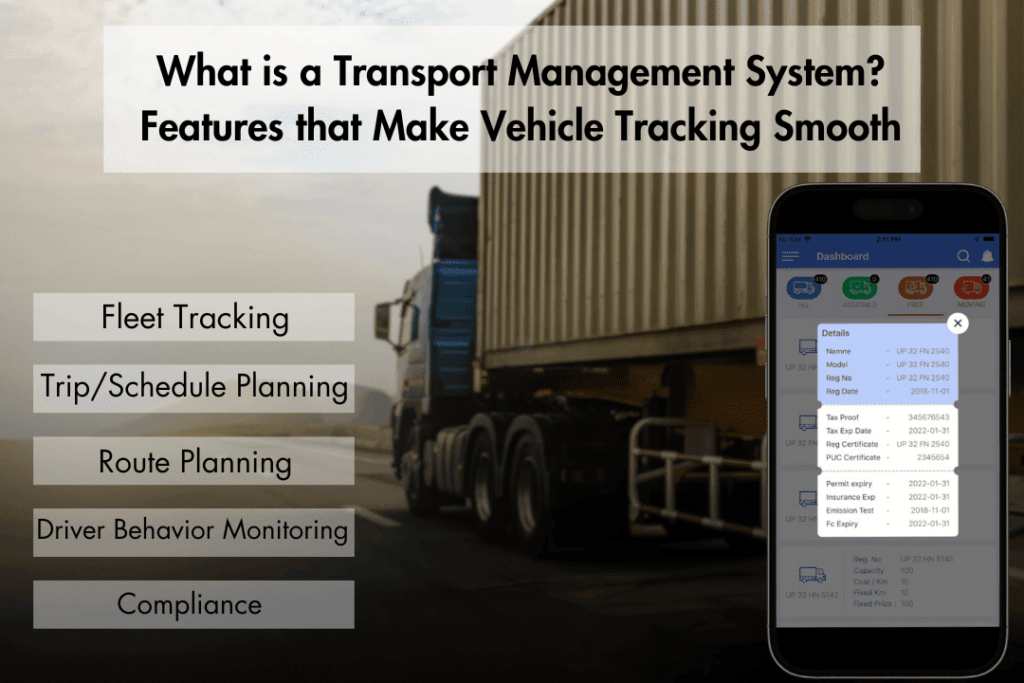Stay Ahead of the Competition: Why Transport Management Solution (VTMS) is a must-have for Timely Deliveries

If you want a seamless, efficient, and cost-effective transport management solution that also speeds up the delivery time, there is nothing better than VTMS software.
It employs advanced systems that put an end to all your logistic-related worries- be it late delivery, lack of visibility, increasing fuel consumption, and more.
In this blog, we will discuss in detail how a transport management solution (VTMS) works in boosting your delivery process.
Keep reading to find out.
What is a Transport Management System? Features that Make Vehicle Tracking Smooth
A transport management solution is a GPS-based fleet management solution designed for organizations to manage their vehicles efficiently.
The primary goal of a VTMS is to streamline and enhance the planning, execution, and monitoring of the transportation processes within a supply chain.
By implementing this software, you can optimize, manage, organize, and coordinate with your whole fleet of vehicles from one single dashboard.
A transport management solution comes with the following advanced features to help you with timely deliveries.

1. Fleet Tracking
Most of these software come with a GPS tracker system ensuring complete visibility of the vehicles, drivers, and goods.
It gives you accurate locations of the vehicles, and you can constantly stay updated on where the vehicles are heading.
2. Trip/Schedule Planning
The tool assists you in planning and optimizing transportation routes and schedules for the entire fleet. It takes into account factors such as delivery windows, traffic conditions, and vehicle availability to create efficient and cost-effective trip plans.
3. Route Planning
The tool will help you plan the most efficient and cost-effective paths for each trip. It considers factors such as distance, traffic conditions, and delivery schedules to minimize travel time and fuel consumption.
Therefore, you can deliver the goods in within the promised deadline and prevent delays.
4. Driver Behavior Monitoring
With the help of this feature, you can track various parameters, such as speeding, harsh braking, and idling.
Analyzing driver behavior data helps identify areas for improvement, enhance safety, and reduce operational costs related to vehicle maintenance and fuel consumption.
Since drivers know they are being watched constantly, there is little to zero chance of improper driving behavior. This means faster and on-time deliveries.
5. Compliance
Compliance features in a Transport Management System ensure that all transportation activities adhere to regulatory and legal requirements.
This includes managing documentation, tracking compliance with transportation laws, and ensuring that vehicles meet safety and environmental standards.
Compliance features are especially critical in industries where adherence to regulations is closely monitored and enforced.
6. Fuel Analytics
Once you implement the system, you’ll get adequate insights into the fuel consumption patterns of the entire fleet.
I’ll help you identify if certain vehicles require more fuel than usual and identify opportunities for fuel cost reduction by optimizing routes, monitoring driver behavior, and identifying fuel-efficient vehicles.
7. Vehicle Health Updates
Vehicle health updates provide real-time information on the condition of each vehicle in the fleet.
Monitoring factors such as engine health, tire pressure, and overall performance is beneficial in preventive maintenance, reducing unexpected breakdowns, and extending the lifespan of vehicles.
As a result, you can deliver orders on time, which in turn increases customer satisfaction.
Conclusion
A vehicle tracking or transport management solution like VTMS brings in a host of features to assist you with 360-degree vehicle monitoring. By taking advantage of the entire features, you can optimize your services and ensure that every delivery is delivered on time.
It will save you time and money and improve customer satisfaction to a great extent. If you’re curious to learn more about how VTMS software can benefit your company, get on a call with us today.
FAQ’S
What exactly is a VTMS, and how does it differ from traditional fleet management systems?
A VTMS, or Vehicle Transport Management System, is a GPS-based fleet management solution that goes beyond traditional systems. While traditional fleet management focuses on vehicle tracking, VTMS integrates advanced features for comprehensive transportation process optimization. It streamlines planning, execution, and monitoring within the supply chain, providing a more holistic approach to managing vehicles efficiently.
How does a VTMS contribute to timely deliveries?
A VTMS contributes to timely deliveries by offering real-time visibility into the entire fleet’s activities. It optimizes route planning, enabling quicker and more efficient delivery schedules. Additionally, the system’s monitoring capabilities help identify and address potential delays, ensuring that vehicles stay on track and deliveries are made promptly.
Can a VTMS help in reducing fuel consumption and overall transportation costs?
Yes, a VTMS plays a crucial role in reducing fuel consumption and transportation costs. By optimizing routes and providing insights into driver behavior, the system helps minimize fuel wastage. Furthermore, efficient planning and monitoring contribute to overall cost reduction by streamlining operations and preventing unnecessary expenses.
How user-friendly is a transport management solution for businesses with varying fleet sizes?
VTMS software is designed to be user-friendly and adaptable to businesses with varying fleet sizes. Its single dashboard interface allows easy management and coordination of the entire fleet, regardless of size. Whether you have a small or large fleet, the intuitive design ensures that businesses can efficiently organize and optimize their transportation processes.
Can a VTMS be integrated with other business systems, and how does this benefit the overall logistics process?
Yes, VTMS can be seamlessly integrated with other business systems such as ERP (Enterprise Resource Planning) and warehouse management systems. This integration ensures a more connected and streamlined logistics process. Real-time data exchange between systems enhances overall visibility, coordination, and decision-making, contributing to a more efficient and well-coordinated supply chain.
Quick Read: From Chaos to Control: How Fleet Management Software Revolutionises Employee Transport